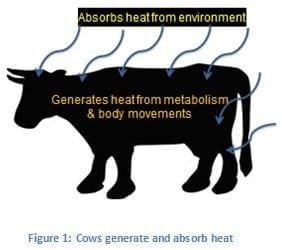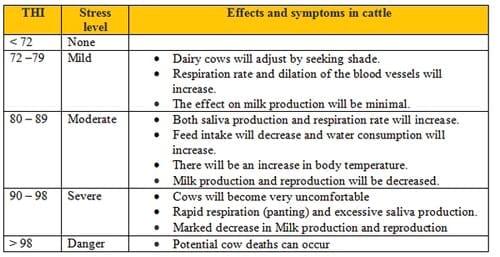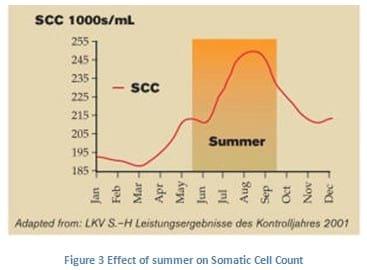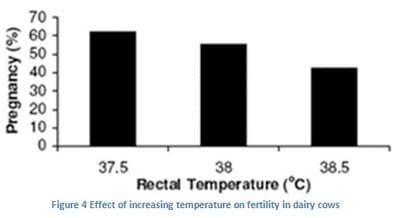Heat Stress in Dairy
Heat Stress Takes Toll on Dairy Animal
Published: February 28, 2012
By: Arindam Chatterjee, Dr.Thirumeignanam, D., Avinash K Singh (Kemin Industries South Asia Pvt. Ltd.)
Heat stress occurs in animals when there is problem in thermoregulation i.e., imbalance between heat production within the body (gain) and its dissipation from the body (loss). Increased ambient temperature may lead to enhanced heat gain as compared to heat loss from the body and cause heat stress in animals. India is a true land of diversity in every aspect from culture, food, dress to weather. Scorching heat and freezing cold both the extremes are prevalent in India subcontinent. Extreme climatic condition takes its toll on milk yield and over-all performance of dairy animals. There has been significant improvement in the genetic potential of dairy animals in last few decades. During summer months, genetic potential of high milk yielding dairy animal lowered due to heat stress. Genetic improvement in milk production is closely associated with increased feed intake. High feed intake results in a metabolic heat increment. Due to high metabolic heat increment in summer months, high producing cows may enter heat stress much earlier than their low producing counter parts.
Internal and External Heat
Cows generate heat internally (metabolic heat) as a result of eating and digesting feed. Like most mammals, the dairy cow needs to maintain its core body temperature within a narrow range around 39oC - between 38.6oC and 39.3oC to be precise! The core temperature fluctuates slightly throughout the day, reaching a peak in the early evening and a low in the early morning. Cows also take heat from the environment around them.

The cycle of gaining and losing heat absorbed from the environment is an on-going process and always operates in the context of the metabolic heat of a cow at any given time.
Factors that determine the level of environmental heat gain or loss in cows are:
- Air temperature and relative humidity;
- Amount of solar radiation;
- Degree of night cooling;
- Ventilation and air flow; and
- Length of the hot conditions.
Cows have evolved a range of physiological strategies to off-load heat to cope in hot environmental conditions but problems occur if temperatures and humidity remain high and cows do not have opportunities to get rid of excess heat.
Temperature Humidity Index
Lactating cows prefer an ambient temperature between 5 and 25º C, the thermo-neutral zone (TNZ). Heat stress is caused by both temperature as well as humidity. Temperature Humidity Index (THI) could be used as an indicator of thermal climatic conditions and has been used since the early 1990s. It accounts for the combined effects of environmental temperature and relative humidity (Figure 2), and is a useful and easy way to assess the risk of heat stress (Table 1).



Table 1. The relationship of THI and heat stress effects in cattle
Heat Stress Causes Oxidative Damage of Cell
Heat stress cause the oxidative damage to the cell by producing reactive oxygen species (ROS) or called as free radicals, the major culprits for destruction of cell. The animal body themselves employs enzymatic antioxidants such as superoxide dismutase (SOD), catalase (CAT) and glutathione peroxidase (GPx) to scavenge the free radicals and reduce the oxidative damage to cell. Thereby, the cell membrane lipid peroxidation is prevented and cell function is maintained in the animal body. But during higher level of environmental and production stress, the enzymatic antioxidants are ineffective in controlling the oxidative damage.
Heat Stress Reduces the Feed Intake and Elevates Cortisol Level and Subsequently Affects Performance
Researchers measure stress by monitoring cow behavior and, most often, by measuring the levels of cortisol, the stress hormone. Cortisol level will be 10 times higher than normal during periods of elevated environmental temperature and humidity. Heat stress takes heavy toll to dairy performance by way of making changes in feed intake, immunity and milk production.
Feed intake: During high environmental body temperature, the animals try to maintain body temperature by minimizing metabolic heat (heat produced during feed digestion and nutrient metabolism) through reducing their feed intake. But, this will lead to low energy intake by animals. At 40ºC, dry matter intake may go down by 40%. In heat stressed dairy animals 30-50% reduction in the efficiency of the energy utilization for milk production has been reported.
Milk let down: Cortisol decreases milk protein synthesis and inhibits the release of oxytocin. Stressed cows have poor milk let down and more residual milk- a risk factor for Mastitis. 10-12% of milk remains as residual milk in udder of slightly stressed cows and in highly stressed cows it may go upto 15-17%. Residual milk is high in fat content hence when the fat rich milk is held back in the udder the fat percentage will be lower in the milk output.
Immunity: Cortisol limits the white blood cell function and replication thereby prevents these cells for protection from infection. Environmental mastitis infections increase during the summer not only because more pathogens exist, but also because of heat stress increasing cortisol level and suppressing the immune function. Increase in somatic cell count in milk during summer months has been reported to be a common phenomenon (Figure 3).

Reproduction: Cortisol level can also cause failure of ovulation in anestrus cows and delayed ovulation in cycling cows. This can decrease fertility in summer. The effects of heat stress can be directly related to the increase in body temperature in heat-stressed cows. Scientific reports showed that small increase in maternal body temperature would cause decreased pregnancy rates in cattle (Figure 4). The increase in body temperature affects the reproductive tract and the early embryo. These changes in the reproductive tract influence the ability of a cow to become pregnant during heat stress.

Strategies for Managing Summer Stress
Practically, two types of strategies can be followed to alleviate the heat stress during summer months in animals. They are
1. Managemental Approach
2. Nutritional Approach
1. Managemental Approach
Shades and Cooling: It is the cheapest way to avoid heat stress in animals. Shades reduce the heat exposure and cooling by fan and water sprinklers reduces the amount heat accumulation in the body.
Milking times: Milking the cows in the afternoon may add to their existing stress. Delaying evening milking until dusk may increase milk yield more than half a litre per day. On hot days we must milk and feed animals before 8 am in the morning. In hot summer months sprinkling of dairy animals before morning and evening milking period can be a fruitful strategy to bring down the effect of heat stress on production.
Plenty of drinking water: Allow cows to drink plenty of cool and clean water in hot summer months- twice the water what cows usually needs in a day. Make sure that cows have access of cool drinking water where ever they are during the day. Large volume concrete troughs help keep drinking water cool. We may avoid running black plastic pipes along the ground, as water will become hot.
2. Nutritional Approach
- Providing more amount of green (green fodder, silages) than dry roughages will increase the intake of feed, nutrient digestibility and energy level in heat stressed animals. During summer period, it is recommended that 75 % of green fodder feeding.
- Feeding of total mixed rations to avoid selective feeding and increase the energy density of diet.
- Increase the feeding frequency during cooler period of the day
- Feeding of by-pass nutrients (fats, protein and limiting amino acids) will improve nutrient density and availability for better milk production
- Further, supplementation of nutrients which play role as antioxidants such as Vitamin C, A and E, zinc and chromium can be used to alleviate the cell oxidative damage of environmental stress and to improve the nutrient utilization for productivity. The authority of Food and Drug Administration (FDA) issued a regulatory discretion letter in 2009 which permitted the use of chromium propionate as a source of supplementary organic chromium in cattle diets.
- In addition, the electrolytes such as Na+, K+, and Cl- in the form of bicarbonate or carbonate and salt supplementation maintains the acid base balance which is disturbed during evaporation of heat by more respiration (panting), sweating and salivation and helps for proper body functions.
Conclusion
Heat stress is greatest concern in high producing dairy cows and buffaloes in tropical countries like India. It reduces feed intake, changes the biochemical profile, acid base balance, decreases the immunity, health and milk production. The effective managemental and nutritional tools should be tried to make the animal in thermo neutral zone, thereby we can reduce the negative effects and increase the genetic potential of dairy animals.
Reference:
1. Sunil Kumar B.V., Kumar Ajeet and Kataria Meena. 2011. Effect of Heat stress in tropical livestock and different strategies for its amelioration. Journal of stress physiology and biochemistry, 7(1):45-54.
2. Kadzere, C.T. Murphy M.R., Silanikove, N. and Maltz E. 2002. Heat stress in lactating dairy cows: a review. Livestock Production Science 77 (2002) 59-91.
3. Ulberg, L.C and P.J. Burfening. 1967: Embryo death resulting from adverse environment on spermatozoa or ova. J. Anim. Sci. 26:571-577.
4. West, J. W. Mullinix, B. G. and Bernard, J. K. 2003. Effects of hot, humid weather on milk temperature, dry matter intake, and milk yield of lactating dairy cows. Journal of Dairy Science 86:232-242.
5. Thirumeignanam, D., Rajalekshmi, M., Nelson Sam, Arindam Chatterjee and Avinash Kumar Singh. 2011. ChromLACTTM improves milk production and reduces blood cortisol level in early lactating cows. Kemin Source Document No:SD-11-00039.
Related topics:
Authors:
Vamso Biotec Pvt Ltd.
Recommend
Comment
Share
Recommend
Reply
Dairy Service Kft.
29 de febrero de 2012
I agree with both previous comments... Have you ever met any groupping of dairy cows inside of new, modern stables? There are more than 100 heat stress days a year in Hungary (considering dairy farming), and the past times we could observe groupping of cows in 30-40 years old barns only. The new generation of stables (12 m high roof, movable curtins on longside walls, fan and spray system, resting boxes etc.) had been introduced in 1999. Several companies are busy in building stables, and from 3 year groupping of cows has appeared in the new-style stables too. All the parameters of building seems to be correct, but groupping is continously exist on the heat-stress months. Have You any comments for solution?
Recommend
Reply
Recommend
Reply

Would you like to discuss another topic? Create a new post to engage with experts in the community.













